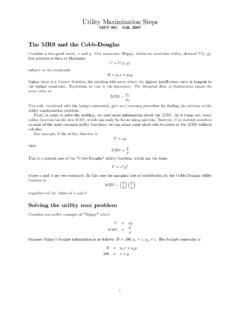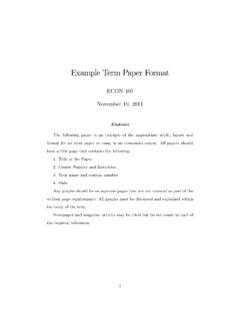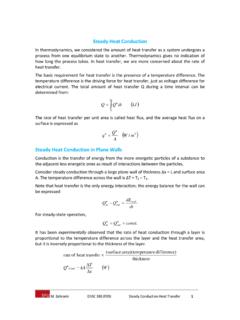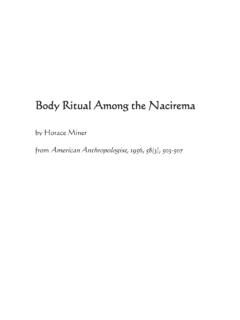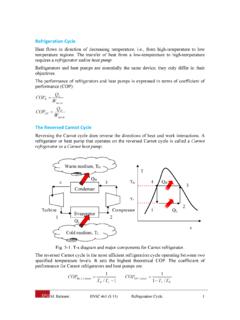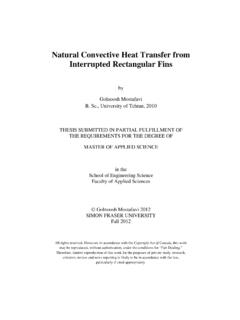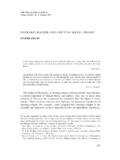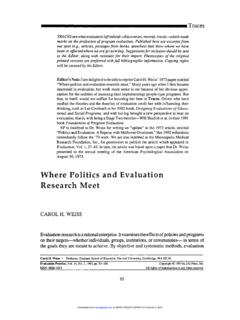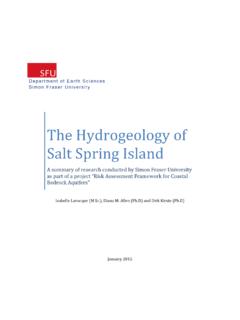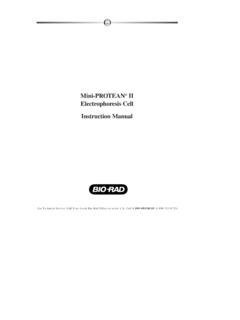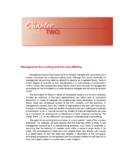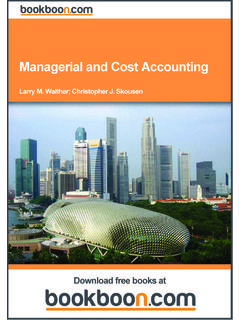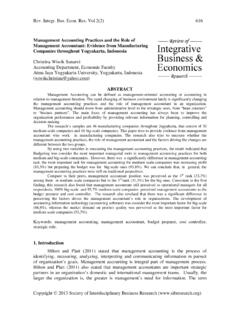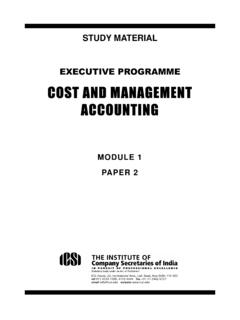Transcription of Theory of the Firm: Managerial Behavior, Agency Costs and ...
1 Theory of the firm : Managerial behavior , Agency Costs and ownership structure Michael C. Jensen Harvard Business School And William H. Meckling University of Rochester Abstract This paper integrates elements from the Theory of Agency , the Theory of property rights and the Theory of finance to develop a Theory of the ownership structure of the firm . We define the concept of Agency Costs , show its relationship to the separation and control issue, investigate the nature of the Agency Costs generated by the existence of debt and outside equity, demonstrate who bears Costs and why, and investigate the Pareto optimality of their existence. We also provide a new definition of the firm , and show how our analysis of the factors influencing the creation and issuance of debt and equity claims is a special case of the supply side of the completeness of markets problem.
2 The directors of such [joint-stock] companies, however, being the managers rather of other people s money than of their own, it cannot well be expected, that they should watch over it with the same anxious vigilance with which the partners in a private copartnery frequently watch over their own. Like the stewards of a rich man, they are apt to consider attention to small matters as not for their master s honour, and very easily give themselves a dispensation from having it. Negligence and profusion, therefore, must always prevail, more or less, in the management of the affairs of such a company. Adam Smith (1776) Keywords: Agency Costs and Theory , internal control systems, conflicts of interest, capital structure , internal equity, outside equity, demand for security analysis, completeness of markets, supply of claims, limited liability 1976 Jensen and Meckling Journal of Financial Economics, October, 1976, V.
3 3, No. 4, pp. 305-360. Reprinted in Michael C. Jensen, A Theory of the firm : Governance, Residual Claims and Organizational Forms (Harvard University Press, December 2000) available at Also published in Foundations of Organizational Strategy, Michael C. Jensen, Harvard University Press, 1998. You may redistribute this document freely, but please do not post the electronic file on the web. I welcome web links to this document at: I revise my papers regularly, and providing a link to the original ensures that readers will receive the most recent version. Thank you, Michael C. Jensen* Associate Professor and Dean, respectively, Graduate School of Management, University of Rochester. Anearlier version of this paper was presented at the Conference on Analysis and Ideology, Interlaken,Switzerland, June 1974, sponsored by the Center for Research in Government Policy and Business at theUniversity of Rochester, Graduate School of Management.
4 We are indebted to F. Black, E. Fama, , W. Klein, M. Rozeff, R. Weil, O. Williamson, an anonymous referee, and to our colleagues andmembers of the Finance Workshop at the University of Rochester for their comments and criticisms, inparticular G. Benston, M. Canes, D. Henderson, K. Leffler, J. Long, C. Smith, R. Thompson, R. Watts, and of the firm : Managerial behavior , Agency Costs and ownership StructureMichael C. JensenHarvard Business SchoolandWilliam H. Meckling*University of Rochester1. of the PaperIn this paper we draw on recent progress in the Theory of (1) property rights, (2) Agency ,and (3) finance to develop a Theory of ownership structure1 for the firm . In addition to tyingtogether elements of the Theory of each of these three areas, our analysis casts new light on andhas implications for a variety of issues in the professional and popular literature including thedefinition of the firm , the separation of ownership and control, the social responsibility ofbusiness, the definition of a corporate objective function, the determination of an optimal capitalstructure, the specification of the content of credit agreements, the Theory of organizations, and thesupply side of the completeness of markets problems.
5 1 We do not use the term capital structure because that term usually denotes the relative quantities ofbonds, equity, warrants, trade credit, etc., which represent the liabilities of a firm . Our Theory implies there isanother important dimension to this problem namely the relative amount of ownership claims held byinsiders (management) and outsiders (investors with no direct role in the management of the firm ).Jensen and Meckling21976 Our Theory helps explain:1. why an entrepreneur or manager in a firm which has a mixed financial structure (containing both debt and outside equity claims) will choose a set of activities for thefirm such that the total value of the firm is less than it would be if he were the soleowner and why this result is independent of whether the firm operates in monopolisticor competitive product or factor markets;2.
6 Why his failure to maximize the value of the firm is perfectly consistent withefficiency;3. why the sale of common stock is a viable source of capital even though managers donot literally maximize the value of the firm ;4. why debt was relied upon as a source of capital before debt financing offered any taxadvantage relative to equity;5. why preferred stock would be issued;6. why accounting reports would be provided voluntarily to creditors and stockholders,and why independent auditors would be engaged by management to testify to theaccuracy and correctness of such reports;7. why lenders often place restrictions on the activities of firms to whom they lend, andwhy firms would themselves be led to suggest the imposition of such restrictions;8. why some industries are characterized by owner-operated firms whose sole outsidesource of capital is borrowing;9.
7 Why highly regulated industries such as public utilities or banks will have higher debtequity ratios for equivalent levels of risk than the average nonregulated firm ;10. why security analysis can be socially productive even if it does not increase portfolioreturns to and of the firm : An Empty Box?While the literature of economics is replete with references to the Theory of the firm , the material generally subsumed under that heading is not actually a Theory of the firm but rather atheory of markets in which firms are important actors. The firm is a black box operated so asto meet the relevant marginal conditions with respect to inputs and outputs, thereby maximizingprofits, or more accurately, present value. Except for a few recent and tentative steps, however,we have no Theory which explains how the conflicting objectives of the individual participants arebrought into equilibrium so as to yield this result.
8 The limitations of this black box view of the firmhave been cited by Adam Smith and Alfred Marshall, among others. More recently, popular andprofessional debates over the social responsibility of corporations, the separation of ownershipand control, and the rash of reviews of the literature on the Theory of the firm have evidencedcontinuing concern with these number of major attempts have been made during recent years to construct a Theory ofthe firm by substituting other models for profit or value maximization, with each attempt motivatedby a conviction that the latter is inadequate to explain Managerial behavior in large of these reformulation attempts have rejected the fundamental principle of maximizing 2 Reviews of this literature are given by Peterson (1965), Alchian (1965, 1968), Machlup (1967), Shubik (1970)
9 ,Cyert and Hedrick (1972), Branch (1973), Preston (1975).3 See Williamson (1964, 1970, 1975), Marris (1964), Baumol (1959), Penrose (1958), and Cyert and March(1963). Thorough reviews of these and other contributions are given by Machlup (1967) and Alchian (1965).Simon (1955) developed a model of human choice incorporating information (search) and computationalcosts which also has important implications for the behavior of managers. Unfortunately, Simon s work hasoften been misinterpreted as a denial of maximizing behavior , and misused, especially in the marketing andbehavioral science literature. His later use of the term satisficing (Simon, 1959) has undoubtedlycontributed to this confusion because it suggests rejection of maximizing behavior rather than maximizationsubject to Costs of information and of decision and Meckling41976behavior as well as rejecting the more specific profit-maximizing model.
10 We retain the notion ofmaximizing behavior on the part of all individuals in the analysis that RightsAn independent stream of research with important implications for the Theory of the firmhas been stimulated by the pioneering work of Coase, and extended by Alchian, Demsetz, A comprehensive survey of this literature is given by Furubotn and Pejovich (1972).While the focus of this research has been property rights ,6 the subject matter encompassed isfar broader than that term suggests. What is important for the problems addressed here is thatspecification of individual rights determines how Costs and rewards will be allocated among theparticipants in any organization. Since the specification of rights is generally affected throughcontracting (implicit as well as explicit), individual behavior in organizations, including the behaviorof managers, will depend upon the nature of these contracts.
